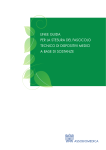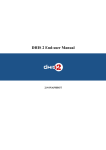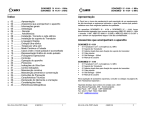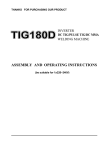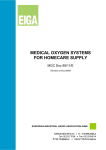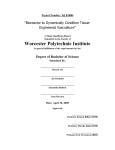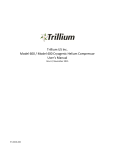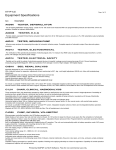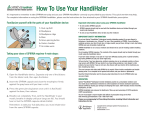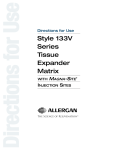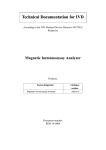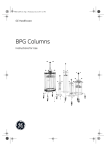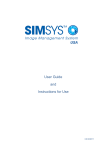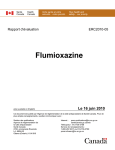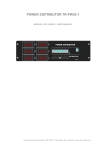Download Technical Construction File
Transcript
Reference: TMTW1506165750 Page 1 of 1 Technical Construction File (File No. TMTW1506165750) Version: 01 HIGH-VOLTAGE ELECTRIC FLELD THERAPY - SAKAE-380MA Model SAKAE-380MA According to Medical Directive 93/42/EEC including 2007/47/EC Issued Date: July 23, 2015 FUWEI HIGH SCIENTIFIC CO.,LTD. No.77 Lane 311, Nangong St.,Yonukang City,Taiwan County 710,Taiwan ( R.O.C.) Reference: TMTW1506165750 Contents Chapter 1. Company introduction Chapter 2. Product introduction Chapter 3. Checklist of essential requirements Chapter 4. Risk Analysis Report Chapter 5. Comprehensive description of the product Chapter 6. Requirements for language and labels Chapter 7. Instructions for use Chapter 8. Product vigilance system Chapter 9. Packaging instruction Chapter 10. Pre-clinical evaluation Chapter 11. Declaration of conformity Annex I: Annex II: Annex III: Annex IV: Authorized representative of EU agreement EN ISO 10993-1: 2009 report Photo documentation The suppliers information Page 1 of 1 Reference: TMTW1506165750 Page 1 of 1 Chapter 1. Company introduction FUWEI HIGH SCIENTIFIC CO.,LTD. No.77 Lane 311, Nangong St.,Yonukang City,Taiwan County 710,Taiwan ( R.O.C.) FUWEI HIGH SCIENTIFIC CO.,LTD. will sincerely cooperate with you and joint your hands to create a splendid future! Contact information: FUWEI HIGH SCIENTIFIC CO.,LTD. No.77 Lane 311, Nangong St.,Yonukang City,Taiwan County 710,Taiwan ( R.O.C.) Reference: TMTW1506165750 Page 1 of 2 Chapter2.Product introduction 1)Product brief introduction Product name: HIGH-VOLTAGE ELECTRIC FLELD THERAPY - SAKAE-380MA Intended use: Product Name HIGH-VOLTAGE ELECTRIC FLELD THERAPY - SAKAE-380MA Models SAKAE-380MA The Manual TMTW1506165750-2012 2)Classification of the product According to the requirements of the intended use of the product and MDD 93/42/EEC: Product name: HIGH-VOLTAGE ELECTRIC FLELD THERAPY - SAKAE-380MA Classification: The above products belong to Class I (Non-sterile) medical devices according to Rule 4 of Classification in Annex IX of MDD 93/42/EEC. Reference: TMTW1506165750 Page 2 of 2 3) List of European Union Harmonized Standards which this product applies. Standard/Directive Version Name of document 93/42/EEC 1993 Medical device directive EN ISO 15223-1 EN 1041 EN ISO 14971 EN 60601-1 EN ISO 10993-1 EN ISO 10993-5 EN ISO 10993-10 Symbols for use in the labeling of medical devices 2012 Medical devices - Symbols to be used with medical device labels, labelling and information to be supplied Part 1: General requirements 2008 Information supplied by the manufacturer of medical devices 2012 Medical devices - Application of risk management to medical devices. 2006+A1:2013 Medical electrical equipment - Part 1: General requirements for basic safety and essential performance 2009+AC:2010 Biological evaluation of medical devices - Part 1 Evaluation and testing within a risk management process - Fourth Edition 2009 Biological evaluation of medical devices Part 5: Tests for in vitro cytotoxicity 2013 Biological evaluation of medical devices Part 10: Tests for irritation and skin sensitization 4)Application method The above product adopts the module of “EC Declaration of Conformity” according to Annex VII of MDD 93/42/EEC. 5)The authorized representative of European Union Reference: TMTW1506165750 93/42/EEC including 2007/47/EC Annex I Essential Requirements Checklist Product name: Type(s)/Model(s): Product group: HIGH-VOLTAGE ELECTRIC FLELD THERAPY - SAKAE-380MA SAKAE-380MA / Issue date of Technical File: July 23, 2015 Legal Manufacturer: Page 1 of 19 Revision of Technical File: Version: 01 FUWEI HIGH SCIENTIFIC CO.,LTD. Name No.77 Lane 311, Nangong St.,Yonukang City,Taiwan County 710,Taiwan ( R.O.C.) Street 710 Taiwan County Postal code Place Taiwan ( R.O.C.) Country Accessories: July 23, 2015 Date Name Reviewer Signature Reviewer 1/ Name Reviewer Signature Reviewer 2 July 23, 2015 Date TMTW1506165750.05-Chapter 3 Essential requirement 200747EC Rev.2; 204-08-10 Reference: TMTW1506165750 Checklist according to annex I of the Medical Device Directive (MDD) A/ NA Documentation (test reports, protocols, literature or reason for no applicability) Requirements fulfilled ( to be filled in by Notified Body) General Requirements I. 1. Standards, other directives and other rules applied by manufacturer The devices must be designed and manufactured in such a way that, when used under the conditions and for the purposes intended, they will not compromise the clinical condition or the safety of patients, or the safety and health of users or, where applicable, other persons, provided that any risks which may be associated with their intended use constitute acceptable risks when weighed against the benefits to the patient and are compatible with a high level of protection of health and safety. A EN ISO 15223-1:2012, EN 1041:2008, EN 60601-1:2006, This shall include: Label Instruction Risk analysis report Test reports EN ISO 14971:2009. * reducing, as far as possible, the risk of use error due to the ergonomic features of the device and the environment in which the device is intended to be used (design for patient safety), and consideration of the technical knowledge, experience, education and training and where applicable the medical and physical conditions of intended users (design for lay, professional, disabled or other users). 2. The solutions adopted by the manufacturer for the design and construction of the devices must conform to safety principles, taking account of the generally acknowledged state of the art. In selecting the most appropriate solutions, the manufacturer must apply the following principles in the following order: A * eliminate or reduce risks as far as possible (inherently safe design and construction), EN ISO 15223-1:2012, EN 1041:2008, EN 60601-1:2006, EN ISO 14971:2009. Label Instruction Risk analysis report Test report * where appropriate take adequate protection measures including alarms if necessary, in relation to risks that cannot be eliminated, TMTW1506165750.05-Chapter 3 Essential requirement 200747EC Page 2 of 19 Rev.2; 204-08-10 Ok / Fail Reference: TMTW1506165750 Checklist according to annex I of the Medical Device Directive (MDD) A/ NA Standards, other directives and other rules applied by manufacturer Documentation (test reports, protocols, literature or reason for no applicability) Requirements fulfilled ( to be filled in by Notified Body) • Inform users of the residual risks due to any shortcomings of the protection measures adopted. 3. 4. 5. 6. 6a. II. The devices must achieve the performances intended by the manufacturer and be designed, manufactured and packaged in such a way that they are suitable for one or more of the functions referred to in Article 1 (2) (a), as specified by the manufacturer. The characteristics and performances referred to in sections 1, 2 and 3 must not be adversely affected to such a degree that the clinical condition and safety of the patients and, where applicable, of other persons are compromised during the lifetime of the device as indicated by the manufacturer, when the device is subjected to the stresses which can occur during normal conditions of use. The devices must be designed, manufactured and packed in such a way that their characteristics and performances during their intended use will not be adversely affected during transport and storage taking account of the instructions and information provided by the manufacturer. A A A EN 60601-1:2006 As above EN ISO 15223-1:2012, EN 1041:2008, EN 60601-1:2006, EN ISO 14971:2009. Any undesirable side effects must constitute an acceptable risk when weighed against the performances intended. A As above Demonstration of conformity with the essential requirements must include a clinical evaluation in accordance with Annex X. A 93/42/EEC , EN ISO14971 Biological evaluation report Test report Label Instruction Risk analysis report Test report Label Instruction Risk analysis report Test report Label Instruction Risk analysis report Test report Risk analysis report REQUIREMENTS REGARDING DESIGN AND CONSTRUCTION TMTW1506165750.05-Chapter 3 Essential requirement 200747EC Page 3 of 19 Rev.2; 204-08-10 Ok / Fail Reference: TMTW1506165750 Checklist according to annex I of the Medical Device Directive (MDD) 7. Chemical, physical and biological properties 7.1 The devices must be designed and manufactured in such a way as to guarantee the characteristics and performances referred to in Section 1 on the "General requirements". Particular attention must be paid to: • the choice of materials used, particularly as regards toxicity and, where appropriate flammability, • the compatibility between the materials used and biological tissues, cells and body fluids, taking account of the intended purpose of the device. A/ NA A Standards, other directives and other rules applied by manufacturer EN ISO 15223-1:2012, EN 1041:2008 EN 60601-1:2006, EN ISO 14971:2009. Documentation (test reports, protocols, literature or reason for no applicability) Requirements fulfilled ( to be filled in by Notified Body) Label Instruction Risk analysis report Test report • Where appropriate, the results of biophysical or modelling research whose validity has been demonstrated beforehand. 7.2 7.3 The devices must be designed, manufactured and packed in such a way as to minimise the risk posed by contaminants and residues to the persons involved in the transport, storage and use of the devices and to the patients, taking account of the intended purpose of the product. Particular attention must be paid to the tissues exposed and the duration and frequency of the exposure. A As above The devices must be designed and manufactured in such a way that they can be used safely with the materials, substances and gases with which they enter into contact during their normal use or during routine procedures; if the devices are intended to administer medicinal products they must be designed and manufactured in such a way as to be compatible with the medicinal products concerned according to the provisions and restrictions governing those products and that their performance is maintained in accordance with the intended use. N/A N/A TMTW1506165750.05-Chapter 3 Essential requirement 200747EC Page 4 of 19 Label Instruction Risk analysis report Test report N/A Rev.2; 204-08-10 Ok / Fail Reference: TMTW1506165750 Checklist according to annex I of the Medical Device Directive (MDD) 7.4 A/ NA Standards, other directives and other rules applied by manufacturer Documentation (test reports, protocols, literature or reason for no applicability) N/A N/A N/A N/A N/A N/A Page 5 of 19 Requirements fulfilled ( to be filled in by Notified Body) Where a device incorporates, as an integral part, a substance which, if used separately, may be considered to be a medicinal product as defined in Article 1 of Directive 2001/83/EC and which is liable to act upon the body with action ancillary to that of the device, the quality, safety and usefulness of the substance must be verified by analogy with the methods specified in Annex I to Directive 2001/83/EC. For the substances referred to in the first paragraph, the notified body shall, having verified the usefulness of the substance as part of the medical device and taking account of the intended purpose of the device, seek a scientific opinion from one of the competent authorities designated by the Member States or the European Medicines Agency (EMEA) acting particularly through its committee in accordance with Regulation (EC) No 726/2004 1 on the quality and safety of the substance including the clinical benefit/risk profile of the incorporation of the substance into the device. When issuing its opinion, the competent authority or the EMEA shall take into account the manufacturing process and the data related to the usefulness of incorporation of the substance into the device as determined by the notified body. Where a device incorporates, as an integral part, a human blood derivative, the notified body shall, having verified the usefulness of the substance as part of the medical device and taking into account the intended purpose of the device, seek a scientific opinion from the EMEA, acting particularly through its committee, on the 1 Regulation (EC) No 726/2004 of the European Parliament and of the Council of 31 March 2004 laying down Community procedures for the authorisation and supervision of medicinal products for human and veterinary use and establishing a European Medicines Agency (OJ L 136, 30.4.2004, p. 1). Regulation as last amended by Regulation (EC) No 1901/2006. TMTW1506165750.05-Chapter 3 Essential requirement 200747EC Rev.2; 204-08-10 Ok / Fail Reference: TMTW1506165750 Checklist according to annex I of the Medical Device Directive (MDD) A/ NA Standards, other directives and other rules applied by manufacturer Documentation (test reports, protocols, literature or reason for no applicability) Requirements fulfilled ( to be filled in by Notified Body) quality and safety of the substance including the clinical benefit/risk profile of the incorporation of the human blood derivative into the device. When issuing this opinion, the EMEA shall take into account the manufacturing process and the data related to the usefulness of incorporation of the substance into the device as determined by the notified body. Where changes are made to an ancillary substance incorporated in a device, in particular related to its manufacturing process, the notified body shall be informed of the changes and shall consult the relevant medicines competent authority (i.e. the one involved in the initial consultation), in order to confirm that the quality and safety of the ancillary substance are maintained. The competent authority shall take into account the data related to the usefulness of incorporation of the substance into the device as determined by the notified body, in order to ensure that the changes have no negative impact on the established benefit/risk profile of the addition of the substance in the medical device. When the relevant medicines competent authority (i.e. the one involved in the initial consultation) has obtained information on the ancillary substance, which could have an impact on the established benefit/risk profile of the addition of the substance in the medical device, it shall provide the notified body with advice, whether this information has an impact on the established benefit/risk profile of the addition of the substance in the medical device or not. The notified body shall take the updated scientific opinion into account in reconsidering its assessment of the conformity assessment procedure. TMTW1506165750.05-Chapter 3 Essential requirement 200747EC Page 6 of 19 Rev.2; 204-08-10 Ok / Fail Reference: TMTW1506165750 Checklist according to annex I of the Medical Device Directive (MDD) 7.5 The devices must be designed and manufactured in such a way as to reduce to a minimum the risks posed by substances leaking from the device. Special attention shall be given to substances which are carcinogenic, mutagenic or toxic to reproduction, in accordance with Annex I to Council Directive 67/548/EEC 2 of 27 June 1967 on the approximation of laws, regulations and administrative provisions relating to the classification, packaging and labelling of dangerous substances 3. If parts of a device (or a device itself) intended to administer and/or remove medicines, body liquids or other substances to or from the body, or devices intended for transport and storage of such body fluids or substances, contain phthalates which are classified as carcinogenic, mutagenic or toxic to reproduction, of category 1 or 2, in accordance with Annex I to Directive 67/548/EEC2, these devices must be labelled on the device itself and/or on the packaging for each unit or, where appropriate, on the sales packaging as a device containing phthalates. A/ NA Standards, other directives and other rules applied by manufacturer Documentation (test reports, protocols, literature or reason for no applicability) N/A N/A N/A N/A N/A N/A Page 7 of 19 Requirements fulfilled ( to be filled in by Notified Body) If the intended use of such devices includes treatment of children or treatment of pregnant or nursing women, the manufacturer must provide a specific justification for the use of these substances with regard to compliance with the essential requirements, in particular of this paragraph, within the technical documentation and, within the instructions for use, information on residual risks for these patient groups and, if applicable, on appropriate precautionary measures. 2 3 Internal note: replaced by (EC) 1272/2008 OJ 196, 16.8.1967, p. 1. Directive as last amended by Directive 2006/121/EC of the European Parliament and of the Council (OJ L 396, 30.12.2006, p. 850). TMTW1506165750.05-Chapter 3 Essential requirement 200747EC Rev.2; 204-08-10 Ok / Fail Reference: TMTW1506165750 Checklist according to annex I of the Medical Device Directive (MDD) 7.6 The devices must be designed and manufactured in such a way as to reduce as much as possible, risks posed by the unintentional ingress of substances into the device taking into account the device and the nature of the environment in which it is intended to be used. 8. Infection and microbial contamination 8.1 The devices and their manufacturing processes must be designed in such a way as to eliminate or reduce as far as possible the risk of infection to the patient, user and third parties. The design must allow easy handling and, where necessary, minimise contamination of the device by the patient or vice versa during use. 8.2 A/ NA A A Standards, other directives and other rules applied by manufacturer EN ISO 15223-1:2012, EN ISO 14971:2009, EN 60601-1:2006, EN ISO 15223-1:2012, EN 1041:2008, EN 60601-1:2006, Requirements fulfilled ( to be filled in by Notified Body) Label Risk analysis report Test report Label Instruction Risk analysis report Test report Tissues of animal origin must originate from animals that have been subjected to veterinary controls and surveillance adapted to the intended use of the tissues. Notified Bodies shall retain information on the geographical origin of the animals. Processing, preservation, testing and handling of tissues, cells and substances of animal origin must be carried out so as to provide optimal security. In particular safety with regard to viruses and other transmissible agents must be addressed by implementation of validated methods of elimination or viral inactivation in the course of the manufacturing process. 8.3 Documentation (test reports, protocols, literature or reason for no applicability) Devices delivered in a sterile state must be designed, manufactured and packed in a non-reusable pack and/or according to appropriate procedures to ensure they are sterile when placed on the market and remain sterile, under the storage and transport conditions laid down, until the protective packaging is damaged or opened. N/A. N/A. N/A. N/A. TMTW1506165750.05-Chapter 3 Essential requirement 200747EC Page 8 of 19 No animal tissue is used in manufacturing this product No sterlization device Rev.2; 204-08-10 Ok / Fail Reference: TMTW1506165750 Checklist according to annex I of the Medical Device Directive (MDD) 8.4 8.5 8.6 8.7 Standards, other directives and other rules applied by manufacturer Devices delivered in a sterile state must have been manufactured and sterilised by an appropriate, validated method.。 N/A. N/A. Devices intended to be sterilised must be manufactured in appropriately controlled (e.g. environmental) conditions. N/A. N/A. Packaging systems for non-sterile devices must keep the product without deterioration at the level of cleanliness stipulated and, if the devices are to be sterilised prior to use, minimise the risk of microbial contamination. The packaging system must be suitable taking account of the method of sterilisation indicated by the manufacturer. N/A. N/A. The packaging and/or label of the device must distinguish between identical or similar products sold in both sterile and non-sterile condition. N/A. N/A. N/A. N/A. 9. Construction and environmental properties 9.1 If the device is intended for use in combination with other devices or equipment, the whole combination, including the connection system must be safe and must not impair the specified performance of the devices. Any restrictions on use must be indicated on the label or in the instruction for use. 9.2 A/ NA Devices must be designed and manufactured in such a way as to remove or minimise as far as possible: • the risk of injury, in connection with their physical features, including the volume/pressure ratio, dimensional, and where appropriate the ergonomic A TMTW1506165750.05-Chapter 3 Essential requirement 200747EC EN ISO 15223-1:2012, EN 1041:2008, EN 60601-1:2006, EN ISO 14971:2009. Documentation (test reports, protocols, literature or reason for no applicability) Page 9 of 19 Requirements fulfilled ( to be filled in by Notified Body) No sterlization device No sterlization device No sterlization device No sterlization device No combination with other devices. Label Instruction Risk analysis report Test report Rev.2; 204-08-10 Ok / Fail Reference: TMTW1506165750 Checklist according to annex I of the Medical Device Directive (MDD) A/ NA Standards, other directives and other rules applied by manufacturer Documentation (test reports, protocols, literature or reason for no applicability) Page 10 of 19 Requirements fulfilled ( to be filled in by Notified Body) features, • risks connected with reasonably foreseeable environmental conditions, such as magnetic fields, external electrical influences, electrostatic discharge, pressure, temperature or variations in pressure, and acceleration, • the risks of reciprocal interference with other devices normally used in the investigations or for the treatment given, • risks arising where maintenance or calibration are not possible (as with implants) from ageing of the materials used or loss of accuracy of any measuring or control mechanism. 9.3 Devices must be designed and manufactured in such a way as to minimise the risks of fire or explosion during normal use and in single fault condition. Particular attention must be paid to devices whose intended use includes exposure to flammable substances which could cause combustion. A EN ISO 15223-1:2012, EN 1041:2008, EN 60601-1:2006, EN ISO 14971:2009. Label Instruction Risk analysis report Test report 10. Devices with a measuring function 10.1 Devices with a measuring function must be designed and manufactured in such a way as to provide sufficient accuracy and stability within appropriate limits of accuracy and taking account of the intended purpose of the device. The limits of accuracy must be indicated by the manufacturer. N/A N/A N/A The measurement, monitoring and display scale must be designed in line with ergonomic principles, taking account of the intended purpose of the device. N/A N/A N/A 10.2 TMTW1506165750.05-Chapter 3 Essential requirement 200747EC Rev.2; 204-08-10 Ok / Fail Reference: TMTW1506165750 Checklist according to annex I of the Medical Device Directive (MDD) 10.3 The measurements made by devices with a measuring function must be expressed in legal units conforming to the provisions of Council Directive 80/181/EEC 4. 11. Protection against radiation 11.1 General 11.1. 1 Devices shall be designed and manufactured such that exposure of patients, users and other persons to radiation shall be reduced as far as possible compatible with the intended purpose, whilst not restricting the application of appropriate specified levels for therapeutic and diagnostic purposes.。 11.2 Intended radiation 11.2. 1 Where devices are designed to emit hazardous levels of radiation necessary for a specific medical purpose the benefit of which is considered to outweigh the risks inherent in the emission, it must be possible for the user to control the emissions. Such devices shall be designed and manufactured to ensure reproducibility and tolerance of relevant variable parameters. 11.2. 2 Where devices are intended to emit potentially hazardous, visible and/or invisible radiation, they must be fitted, where practicable, with visual displays and/or audible warnings of such emissions. 11.3 Unintended radiation 11.3. Devices shall be designed and manufactured in such a 4 A/ NA Standards, other directives and other rules applied by manufacturer Documentation (test reports, protocols, literature or reason for no applicability) N/A N/A N/A N/A N/A N/A N/A N/A N/A N/A N/A N/A N/A N/A N/A Page 11 of 19 Requirements fulfilled ( to be filled in by Notified Body) OJ No L 39, 15. 2. 1980, p. 40. Directive as last amended by Directive 89/617/EEC (OJ No L 357, 7. 12. 1989, p. 28). TMTW1506165750.05-Chapter 3 Essential requirement 200747EC Rev.2; 204-08-10 Ok / Fail Reference: TMTW1506165750 Checklist according to annex I of the Medical Device Directive (MDD) 1 way that exposure of patients, users and other persons to the emission of unintended, stray or scattered radiation is be reduced as far as possible. 11.4 Instructions 11.4. 1 The operating instructions for devices emitting radiation must give detailed information as to the nature of the emitted radiation, means of protecting the patient and the user and on ways of avoiding misuse and of eliminating the risks inherent in installation. 11.5 Ionising radiation 11.5. 1 Devices intended to emit ionising radiation must be designed and manufactured in such a way as to ensure that, where practicable, the quantity, geometry and quality of radiation emitted can be varied and controlled taking into account the intended uses. A/ NA Standards, other directives and other rules applied by manufacturer Documentation (test reports, protocols, literature or reason for no applicability) N/A N/A N/A N/A N/A N/A 11.5. 2 Devices emitting ionising radiation intended for diagnostic radiology shall be designed and manufactured in such a way, as to achieve appropriate image and/or output quality for the intended medical purpose whilst minimising radiation exposure of the patient and user. N/A N/A N/A 11.5. 3 Devices emitting ionising radiation intended for therapeutic radiology shall be designed and manufactured in such a way as to enable reliable monitoring and control of the delivered dose, the beam type and energy and where appropriate the quality of the radiation. N/A N/A N/A N/A N/A N/A 12. Requirements for medical devices connected to or equipped with an energy source 12.1 Devices incorporating electronic programmable systems must be designed to ensure the repeatability, reliability and performance of these systems according to their TMTW1506165750.05-Chapter 3 Essential requirement 200747EC Page 12 of 19 Requirements fulfilled ( to be filled in by Notified Body) Rev.2; 204-08-10 Ok / Fail Reference: TMTW1506165750 Checklist according to annex I of the Medical Device Directive (MDD) A/ NA Standards, other directives and other rules applied by manufacturer Documentation (test reports, protocols, literature or reason for no applicability) Page 13 of 19 Requirements fulfilled ( to be filled in by Notified Body) intended use. In the event of a single fault condition (in the system) appropriate means should be adopted to eliminate or reduce as far as possible consequent risks 12.1 a For devices which incorporate software or which are medical software in themselves, the software must be validated according to the state of the art taking into account the principles of development lifecycle, risk management, validation and verification. N/A N/A N/A 12.2 Devices where the safety of the patients depends on an internal power supply must be equipped with a means of determining the state of the power supply. N/A N/A N/A 12.3 Devices where the safety of the patient depends on an external power supply must include an alarm system to signal any power failure. N/A N/A N/A 12.4 Devices intended to monitor one or more clinical parameters of a patient must be equipped with appropriate alarm systems to alert the user of situations which could lead to death or severe deterioration of the patient's state of health. N/A N/A N/A 12.5 12.6 Devices must be designed and manufactured in such a way as to minimise the risks of creating electromagnetic fields which could impair the operation of other devices or equipment in the usual environment.。 N/A EN ISO 14971:2009. Risk analysis report Test reports Protection against electrical risks Devices must be designed and manufactured in such a way as to avoid, as far as possible, the risk of accidental electric shocks during normal use and in single fault condition, provided that the devices are installed correctly. 12.7 EN 60601-1:2006, Protection against mechanical and thermal risks Devices must be designed and manufactured in such a EN 60601-1:2006, A EN ISO 14971:2009. EN 60601-1:2006, A TMTW1506165750.05-Chapter 3 Essential requirement 200747EC Risk analysis report Test reports Risk analysis report Test reports EN ISO 14971:2009. Rev.2; 204-08-10 Ok / Fail Reference: TMTW1506165750 Checklist according to annex I of the Medical Device Directive (MDD) A/ NA Standards, other directives and other rules applied by manufacturer Documentation (test reports, protocols, literature or reason for no applicability) 12.7. 1 way as to protect the patient and user against mechanical risks connected with, for example, resistance, stability and moving parts. 12.7. 2 Devices must be designed and manufactured in such a way as to reduce to the lowest possible level the risks arising from vibration generated by the devices, taking account of technical progress and of the means available for limiting vibrations, particularly at source, unless the vibrations are part of the specified performance. 12.7. 3 Devices must be designed and manufactured in such a way as to reduce to the lowest possible level the risks arising from the noise emitted, taking account of technical progress and of the means available to reduce noise, particularly at source, unless the noise emitted is part of the specified performance. A 12.7. 4 The terminals and connectors to the electricity, gas or hydraulic and pneumatic energy supplies which the user has to handle must be designed and constructed in such a way as to minimise all possible risks. N/A N/A 12.7. 5 Accessible parts of devices (excluding any parts or areas intended to supply heat or reach given temperatures) and their surroundings must not attain potentially dangerous temperatures under normal use. N/A N/A 12.8 Protection against the risks posed to the patient by energy supplies or substances N/A N/A N/A N/A N/A N/A 12.8. 1 Devices for supplying the patient with energy or substances must be designed and constructed in such a way that the flow rate can be set and maintained accurately enough to guarantee the safety of the patient and of the user. 12.8. Devices must be fitted with the means of preventing and/or indicating any inadequacies in the flow-rate which N/A TMTW1506165750.05-Chapter 3 Essential requirement 200747EC N/A Page 14 of 19 Requirements fulfilled ( to be filled in by Notified Body) N/A EN ISO 14971:2009. Risk analysis report Test report N/A No high temperature possibility Rev.2; 204-08-10 Ok / Fail Reference: TMTW1506165750 Checklist according to annex I of the Medical Device Directive (MDD) 2 A/ NA Standards, other directives and other rules applied by manufacturer Documentation (test reports, protocols, literature or reason for no applicability) N/A N/A Page 15 of 19 Requirements fulfilled ( to be filled in by Notified Body) could pose a danger. Devices must incorporate suitable means to prevent, as far as possible, the accidental release of dangerous levels of energy from an energy and/or substance source. 12.9 The function of the controls and indicators must be clearly specified on the devices. Where a device bears instructions required for its operation or indicates operating or adjustment parameters by means of a visual system, such information must be understandable to the user and, as appropriate, the patient. 13. Information supplied by the manufacturer 13.1 Each device must be accompanied by the information needed to use it safely and properly, taking account of the training and knowledge of the potential users, and to identify the manufacturer. N/A This information comprises the details on the label and the data in the instructions for use. As far as practicable and appropriate, the information needed to use the device safely must be set out on the device itself and/or on the packaging for each unit or, where appropriate, on the sales packaging. If individual packaging of each unit is not practicable, the information must be set out in the leaflet supplied with one or more devices. A EN ISO 15223-1:2012, EN 1041:2008. Label Instruction EN ISO 15223-1:2012, EN 1041:2008. Label Instruction Instructions for use must be included in the packaging for every device. By way of exception, no such instruction leaflet is needed for devices in Class I or Class IIa if they can be used completely safely without any such instructions. 13.2 Where appropriate, this information should take the form A TMTW1506165750.05-Chapter 3 Essential requirement 200747EC Rev.2; 204-08-10 Ok / Fail Reference: TMTW1506165750 Checklist according to annex I of the Medical Device Directive (MDD) A/ NA Standards, other directives and other rules applied by manufacturer Documentation (test reports, protocols, literature or reason for no applicability) Page 16 of 19 Requirements fulfilled ( to be filled in by Notified Body) of symbols. Any symbol or identification colour used must conform to the harmonised standards. In areas for which no standards exist, the symbols and colours must be described in the documentation supplied with the device. 13.3 The label must bear the following particulars: a) the name or trade name and address of the manufacturer. For devices imported into the Community, in view of their distribution in the Community, the label, or the outer packaging, or instructions for use, shall contain in addition the name and address of the authorised representative where the manufacturer does not have a registered place of business in the Community; b) the details strictly necessary to identify the device and the contents of the packaging especially for the users; A EN ISO 15223-1:2012, EN 1041:2008. Label Instruction A EN ISO 15223-1:2012, EN 1041:2008. Label Instruction c) where appropriate, the word "STERILE"; d) where appropriate, the batch code, preceded by the word "LOT", or the serial number; e) where appropriate, an indication of the date by which the device should be used, in safety, expressed as the year and month; f) where appropriate, an indication that the device is for single use. A manufacturer’s indication of single use must be consistent across the Community; g) if the device is custom made, the words "custom made device"; h) if the device is intended for clinical investigations, the words "exclusively for clinical investigations";字样 i) any special storage and/or handling conditions; TMTW1506165750.05-Chapter 3 Essential requirement 200747EC Rev.2; 204-08-10 Ok / Fail Reference: TMTW1506165750 Checklist according to annex I of the Medical Device Directive (MDD) A/ NA Standards, other directives and other rules applied by manufacturer Documentation (test reports, protocols, literature or reason for no applicability) Page 17 of 19 Requirements fulfilled ( to be filled in by Notified Body) j) any special operating instructions; k) any warnings and/or precautions to take; l) year of manufacture of active devices other than those covered by e). This indication may be included in the batch or serial number; m) where applicable, method of sterilisation. n) in the case of a device within the meaning of Article 1(4a), an indication that the device contains a human blood derivative." 13.4 If the intended purpose of the device is not obvious to the user, the manufacturer must clearly state it on the label and in the instructions for use. A EN ISO 15223-1:2012, EN 1041:2008. Label Instruction 13.5 Wherever reasonable and practicable, the devices and detachable components must be identified, where appropriate in terms of batches, to allow all appropriate action to detect any potential risk posed by the devices and detachable components. A EN ISO 15223-1:2012, EN 1041:2008. Label Instruction A EN ISO 15223-1:2012, EN 1041:2008. Label Instruction 13.6 Where appropriate, the instructions for use must contain the following particulars: a) the details referred to in 13.3, with the exception of d) and e) b) the performances referred to in section 3 and any undesirable side effects; c) if the device must be installed with or connected to other medical devices or equipment in order to operate as required for its intended purpose, sufficient details of its characteristics to identify the correct devices or equipment to use in order to obtain a safe combination; TMTW1506165750.05-Chapter 3 Essential requirement 200747EC Rev.2; 204-08-10 Ok / Fail Reference: TMTW1506165750 Checklist according to annex I of the Medical Device Directive (MDD) A/ NA Standards, other directives and other rules applied by manufacturer Documentation (test reports, protocols, literature or reason for no applicability) Page 18 of 19 Requirements fulfilled ( to be filled in by Notified Body) d) all the information needed to verify whether the device is properly installed and can operate correctly and safely, plus details of the nature and frequency of the maintenance and calibration needed to ensure that the devices operate properly and safely at all times; e) where appropriate, information to avoid certain risks in connection with implantation of the device; f) information regarding the risks of reciprocal interference posed by the presence of the device during specific investigations or treatment; g) the necessary instructions in the event of damage to the sterile packaging and, where appropriate, details of appropriate methods of re-sterilisation h) if the device is reusable, information on the appropriate processes to allow reuse, including cleaning, disinfection, packaging and, where appropriate, the method of sterilization of he device to be resterilized, and any restriction on the number if reuses. Where devices are supplied with the intention that they be sterilized before use, the instructions for cleaning and sterilization must be such that, if correctly followed, the device will still comply with the requirements in Section I). If the device bears an indication that the device is for single use, information on known characteristics and technical factors known to the manufacturer that could pose a risk if the device were to be re-used. If in accordance with Section 13.1 no instructions for use are needed, the information must be made available to the user upon request; i) details of any further treatment or handling needed before the device can be used (for example, A TMTW1506165750.05-Chapter 3 Essential requirement 200747EC EN ISO 15223-1:2012, EN 1041:2008. Label Instruction Rev.2; 204-08-10 Ok / Fail Reference: TMTW1506165750 Checklist according to annex I of the Medical Device Directive (MDD) A/ NA Standards, other directives and other rules applied by manufacturer Documentation (test reports, protocols, literature or reason for no applicability) Page 19 of 19 Requirements fulfilled ( to be filled in by Notified Body) sterilisation, final assembly, etc.) j) in the case of devices emitting radiation for medical purpose, details of the nature, type intensity and distribution of this radiation The instruction for use must also include details, allowing the medical staff to brief the patient on any contra-indications and any precautions to be taken. These details should cover in particular: k) precautions to be taken in the event of changes in the performance of the device; l) precautions to be taken as regards exposure, in reasonably foreseeable environmental conditions, to magnetic fields, external electrical influences, electrostatic discharge, pressure or variations in pressure, acceleration, thermal ignition sources etc.; m) adequate information regarding the medicinal product or products which the device in question is designed to administer, including any limitations in the choice of substances to be delivered; n) precautions to be taken against any special, unusual risks related to the disposal of the device; o) medicinal substances, or human blood derivatives incorporated into the device as an integral part in accordance with Section 7.4; p) degree of accuracy claimed for devices with a measuring function. q) date of issue or the latest revision of the instructions for use. TMTW1506165750.05-Chapter 3 Essential requirement 200747EC Rev.2; 204-08-10 Ok / Fail Technical File 4. Risk Management File No. TMTW1506165750 Rev. No. Eff. Date Page Rev. 01 July 11, 2015 Page 1 of 11 Risk Analysis Report Company Name: FUWEI HIGH SCIENTIFIC CO.,LTD. Company Address: No.77 Lane 311, Nangong St.,Yonukang City,Taiwan County 710,Taiwan ( R.O.C.) Product: High-Voltage Electric Fleld Therapy - SAKAE-380ma Model: SAKAE-380MA Accessories: No Standard: EN ISO 14971:2012 Result: All risks associated with the identified hazards have been evaluated. After appropriate measures to reduce these risks have been taken, the overall level of risk of the product is acceptable with regard to the intended application and use of the application. Compiled by: (Name/Title/Dept.) / Quality Engineer Date: July 11, 2015 / Quality Chief Engineer Date: July 11, 2015 Reviewed by (Name/Title/Dept.) Approved by: (Name/Title/Dept.) / Technical & Quality Manager Date: July 11, 2015 Technical File 4. Risk Management File No. TMTW1506165750 Rev. No. Eff. Date Rev. 01 July 11, 2015 (acc. to EN ISO 14971:2012, Annex C.2) Identification of qualitative and quantitative characteristics (acc. to EN ISO 14971:2012, Annex C.2) 1 2 3 4 5 6 7 8 9 10 11 12 13 14 15 16 17 18 19 20 21 22 23 24 25 26 Intended use and how to use Is implanted? Intended to contact patient or other person Materials/components used Energy to/from patient Substances to /from patient Biological materials processed Sterile/Intended to be sterilized routinely cleaned and disinfected by the user Modify patient environment Measurements Interpretative use in conjunction with medicines or other medical technologies Unwanted outputs of energy or substances Susceptible to environmental influences influence the environment Consumables/accessorie s associated Routine maintenance/calibration Software Restricted “shelf-life”: Delayed and/or longterm use effect Mechanical forces Lifetime of the device determined Single use/re-use safe decommissioning or disposal Special training required to install or use N/A N/A N/A N/A N/A N/A N/A N/A N/A N/A N/A N/A N/A N/A N/A Routine maintenance. N/A N/A No effect unless the device is damaged. Mechanical forces. Wear and tear of the device components. Re-use N/A N/A Technical File 4. Risk Management File No. TMTW1506165750 Rev. No. Eff. Date Rev. 01 July 11, 2015 Information for safe use By symbol and label. new manufacturing New manufacturing processes was established. processes need to be established or introduced successful application of N/A 29 the medical device critically dependent on human factors, such as user interface N/A 29.1 User interface design features contribute to use error Yes. 29.2 Used in distraction environment N/A 29.3 connecting parts or accessories N/A 29.4 control interface N/A 29.5 display information controlled by a menu N/A 29.6 N/A 29.7 Used by persons with special needs N/A 29.8 Initiate user actions Alarm system N/A 30 Deliberately misused N/A 31 Data critical to patient N/A 32 care? To be mobile or portable Mobile 33 Depend on essential Depend on device’s physical essential performance. 34 performance? Letters in the first column refer to EN ISO 14971:2012, Annex C.2 27 28 Reference: TMTW1506165750 Page 4 of 11 Risk Analysis Company: No. FUWEI HIGH SCIENTIFIC CO.,LTD. Hazards General Products : ORTHOPAEDIC BRACES &SUPPORT Risk Evaluation Risk Reduction Measure Evidence 8 neglectable risk, no further actions Symbol 1 8 neglectable risk, no further actions Symbol 2 7 3 neglectable risk, no further actions 6 7 5 4 22 25 Identify hazards S O D RL Electricity leakage hazard may happen N/A Mechanical force during operation collides patients’ body. N/A N/A Electromagnetic hazard may happen N/A N/A N/A 7 2 1 2 2 1 4 5 D2. Energy Hazards 1 Electricity 2 3 Heat Mechanical force 4 5 6 Ionizing radiation Non-ionizing radiation Electromagnetic fields 7 8 9 Moving parts Suspended masses Patient support device failure Pressure(vessel rupture) Acoustic pressure Vibration Magnetic fields(e.g. MRI) 10 11 12 13 N/A N/A N/A N/A D3. Biological hazards 1 2 3 4 5 6 7 8 9 10 Bio-contamination Bio-incompatibility Incorrect formulation(chemical composition) Toxicity allergenicity mutagenicity oncogenicity teratogenicity Carcinogenicity Re-and/or crossinfection N/A N/A N/A N/A N/A N/A N/A N/A N/A N/A NH ALOR Reference: TMTW1506165750 Page 5 of 11 Risk Analysis Company: No. 11 12 13 FUWEI HIGH SCIENTIFIC CO.,LTD. Hazards General pyrogenicity Inability to maintain hygienic safety Degradation Products : ORTHOPAEDIC BRACES &SUPPORT Risk Evaluation Identify hazards N/A N/A Risk Reduction Measure S O D RL Electromagnetic hazard may happen N/A 1 2 7 3 No electronic component provided Electromagnetic hazard may happen 1 2 7 3 No electronic component provided Electromagnetic hazard may happen 1 2 7 3 No electronic component provided 8 No electronic component provided Evidence N/A D4. Environmental hazards and contributory factors 1 electromagnetic fields 2 Inadequate supply of power or coolant Susceptibility to electromagnetic interference Emissions of electromagnetic interference Inadequate supply of power inadequate supply of coolant Storage or operation outside prescribed environmental conditions Incompatibility with other devices Accidental mechanical damage Contamination due to waste products and /or device disposal 3 4 5 6 7 8 9 10 N/A N/A N/A N/A N/A N/A D5. Hazards resulting from incorrect output of energy and substances 1 electricity 2 radiation Electricity leakage hazard may happen N/A 7 2 1 Symbol NH ALOR Reference: TMTW1506165750 Page 6 of 11 Risk Analysis Company: No. 3 4 5 6 FUWEI HIGH SCIENTIFIC CO.,LTD. Hazards General volume pressure supply of medical gases supply of anaesthetic agents Products : ORTHOPAEDIC BRACES &SUPPORT Risk Evaluation Identify hazards N/A N/A N/A N/A S O D RL Risk Reduction Measure Evidence NH ALOR D6. Hazards related to the use of the device and contributory factors 1 2 3 4 5 6 7 Inadequate labeling Inadequate operating instructions: - inadequate specification of accessories - inadequate specification of pre-use checks - over-complicated operating instructions - inadequate specification of service and maintenance Use by unskilled/untrained personnel Reasonably foreseeable misuse Insufficient warning of side effects Inadequate warning of hazards likely with reuse of single use devices Incorrect measurement and other metrological A Inadequate operating instructions may cause wrong use of the device resulting in hurting patients. 5 6 2 2 4 4 19 26 Preventing wrong label Preventing wrong label Labels and Instruction Labels and Instruction No No Yes Yes Unskilled/untrained personnel may cause wrong use of the device resulting in hurting patients. Misuse may cause wrong use of the device resulting in hurting patients. N/A 5 2 4 19 Preventing wrong label Labels and Instruction No Yes 2 2 1 7 neglectable risk, no further actions. Labels N/A N/A Reference: TMTW1506165750 Page 7 of 11 Risk Analysis Company: No. 8 9 FUWEI HIGH SCIENTIFIC CO.,LTD. Hazards General aspects Incompatibility with consumables/accessori es/other devices sharp edges or points Products : ORTHOPAEDIC BRACES &SUPPORT Risk Evaluation Identify hazards S O D RL 7 5 1 30 Risk Reduction Measure Evidence NH ALOR Removing all sharp edges or points No edeges or points in the device No Yes N/A Sharp edges hurts patients’ body C7. Inappropriate, inadequate or over-complicated user interface (man/machine communication) 1 2 3 4 5 6 7 8 9 10 Mistakes and judgement errors Lapses and cognitive recall errors Slips and blunders (mental or physical) Violation or abbreviation of instructions, procedures, etc., Complex or confusing control system Ambiguous or unclear device state Ambiguous or unclear presentation of settings, measurements or other information Mispresentation of results Insufficient visibility, audibility or tactility Poor mapping of controls to action, or of displayed information to actual state N/A N/A N/A N/A N/A N/A N/A N/A N/A N/A Reference: TMTW1506165750 Page 8 of 11 Risk Analysis Company: No. 11 FUWEI HIGH SCIENTIFIC CO.,LTD. Hazards General Controversial modes or mappings as compared to existing equipment Products : ORTHOPAEDIC BRACES &SUPPORT Risk Evaluation Identify hazards N/A S O D RL 5 10 Risk Reduction Measure Evidence NH ALOR Symbol and instruction Symbol and instruction No Yes D8. Hazards arising from functional failure, maintenance and ageing 1 2 3 4 5 6 7 8 Erroneous data transfer Lack of , or inadequate specification for maintenance including inadequate specification of post maintenance functional checks Inadequate maintenance Lack of adequate determination of end of device life Loss of electrical / mechanical integrity Inadequate packaging(contaminatio n and /or deterioration of the device ) re-use and / or Improper re-use Deterioration in function (e.g. gradual occlusion of fluid/gas path, or change in resistance to flow, electrical conductivity) as a result of repeated use. N/A N/A Inadequate maintenance damages the device influencing its use life. N/A N/A N/A N/A N/A B2. Additional hazards to in vitro diagnostic medical devices 1 Batch inhomogeneity, N/A 4 2 Reference: TMTW1506165750 Page 9 of 11 Risk Analysis Company: No. 2 3 4 5 6 7 8 FUWEI HIGH SCIENTIFIC CO.,LTD. Hazards General batch-to-batch inconsistency Common interfering factors Carry-over effects Specimen identification errors Stability problems (in storage, in shipping, in use, after first opening of the container) Problems related to taking, preparation and stability of speciments Inadequate specification of prerequisites 不适当的试验特性) Inadequate test characteristics Products : ORTHOPAEDIC BRACES &SUPPORT Risk Evaluation Identify hazards S O D Risk Reduction Measure Evidence NH ALOR RL N/A N/A N/A N/A N/A N/A N/A Post-production information Post-production experience: Establishing a system to collect and review information about the medical device, and all these information were collected by QC department from customers and being considered Review of risk management experience: It is acceptable. Reference: TMTW1506165750 Page 10 of 11 Risk Analysis Company: Product: FUWEI HIGH SCIENTIFIC CO.,LTD. ORTHOPAEDIC BRACES &SUPPORT Abbreviations used RE Risk Evaluation S Severity (10 –very severe, 1 –not severe) O Occurrence (10 –often, 1 never) D Detection (10 –impossible to detect before risk occurs, 1 –will be certainly detected before risk occurs) RL Risk Level = Severity × Occurrence × Detection 1-9: neglectable risk, no further actions; 9-24: moderate: minimal risk, preventive action recommended; 25-48: moderate risk, preventive action required; >48: risk is usually not acceptable RRM NH ALOR Risk Reduction Measure New hazard generated (no/ yes - if yes, then number of new hazard indicated) Acceptable Level of Risk SEVERITY of Effect Injure a customer or employee Be illegal Render product or service unfit for use Ranking 10 9 8 Cause extreme customer dissatisfaction 7 Result in partial malfunction Cause a loss of performance which is likely to result in a complaint Cause minor performance loss 6 5 4 Cause a minor nuisance but can be overcome with no performance loss 3 Be unnoticed and have only minor effect on performance 2 Be unnoticed and not affect the performance 1 Reference: TMTW1506165750 Page 11 of 11 Risk Analysis Company: Product: FUWEI HIGH SCIENTIFIC CO.,LTD. ORTHOPAEDIC BRACES &SUPPORT PROBABILITY of Failure Failure Prob Very High: Failure is almost inevitable >1 in 2 1 in 3 1 in 8 High: Repeated failures 1 in 20 1 in 80 Moderate: Occasional failures 1 in 400 1 in 2,000 1 in 15,000 Low: Relatively few failures 1 in 150,000 Remote: Failure is unlikely Detection <1 in 1,500,000 Likelihood of DETECTION by Design Control Ranking 10 9 8 7 6 5 4 3 2 1 Ranking 10 Absolute Uncertainty Defect caused by failure is not cetectable Very Remote Occasional units are checked for defect Remote Units are systematically sampled and inspected Very Low All units are manually inspected Low Manual inspection with mistake-proofing modifications Moderate Process is monitored(SPC) and manually inspected Moderately High SPC is used with an immediate reaction to out of control conditions High SPC as above with 100% inspection sourrounding out of control conditions 3 Very High All units are automatically inspected Almost Certain Defect is obvious and can be kept from affecting the customer 2 1 - End of Risk Analysis Report - 9 8 7 6 5 4 Reference: TMTW1506165750 Chapter 5. Comprehensive description of the product 5.1 Product specification and pictures Model SAKAE-380MA Model SAKAE-380MA Description HIGH-VOLTAGE ELECTRIC FLELD THERAPY SAKAE-380MA Remark Page 1 of 2 Reference: TMTW1506165750 5.2 Production procedure and quality control 5.2.1 Production procedure R&D Dept. P&S Dept. Procurement Peripherals Workshop Test Test In-process Storage Storage Can Pack Final test Finished - End of Comprehensive Description of the Product- Page 2 of 2 Reference: TMTW1506165750 Chapter 6. Page 1 of 2 Requirements for language and labels 6.1 design of the label: The product produced by our company labeled with the following information: a. Product name, type and quantity b. CE mark: pieced with two semi-circles with its diameter no less than 5mm c. Batch number, production date and valid time d. Manufacturer name e. Manufacturer address, telephone number and fax number f. Name and address of the EC representative 6.2 conformity and accuracy of the label: According to the requirements of MDD 93/42/EEC, the medical products supplied to European market should be labeled in line with the specification. Label content: Product name and Quantity,Type; Symbol for “DO NOT REUSE” (The product is for single use.) LOT for “BATCH CODE” (the symbol should be attached with batch code and be Symbol close to the graph, batch code, lot number and batch number). Examples: LOT ABC123 Symbol for “DATE OF MANUFACTURE” (the symbol should be close to the number) Symbol for “MANUFACTURE” Symbol for “EC REPRESENTATIVE” Symbol for “ATTENTION, SEE INSTRUCTIONS FOR USE” Attaching CE marking indicates that: This device meets the basic requirements of MDD. This device can be legally put on the market of Europe. This device has passed a relevant conformity estimation program. There are two types of CE Marking attached on the medical devices: CE marking without identified number of Notified Body and CE marking with identified number of Notified Body. CE marking without identified number only apply to the Class I medical devices, which needn’t to be sterilized and have no measure function. 6.3 Translation procedures and control: The labeling must use local official language to avoid accidents caused by inadequate translation. 6.3.1 The international trade department and the technology department are accountable for the labeling translation and check. 6.3.2 If labeling translation is done by other company, the international trade department and the technology department are responsible for checking. Reference: TMTW1506165750 Page 2 of 2 6.4 special requirements: In addition to meet the special requirement of the clients about the label, if they had, the left content should be design as the above form FUWEI HIGH SCIENTIFIC CO.,LTD. Product Name: HIGH-VOLTAGE ELECTRIC FLELD THERAPY - SAKAE-380MA Model: XX Specs: XX LOT Lot Number: XX YY - MM - DD Quantity: XX User Manual Applicant/Holder: Manufacturer: Reference No. TMTW1506165750 Revision: 2014-08 Page 1 of 1 FUWEI HIGH SCIENTIFIC CO.,LTD. No.77 Lane 311, Nangong St.,Yonukang City,Taiwan County 710,Taiwan ( R.O.C.) Ahead Electrical Co., Ltd. No.6-56, Nanjin Rd., Wanluan Township,Pingtung County 92341, Taiwan ( R.O.C.) Product Type: High-Voltage Electric Fleld Therapy - SAKAE-380ma Models: SAKAE-380ma Reference: TMTW1506165750 Chapter 8. Page 1 of 3 Product vigilance system 8.1 Purpose The purpose of this vigilance system is to decrease repeatedly happen of accidents which are informed, reported and evaluated, also releasing relevant information so that the safety and health of patients or users will be guaranteed. 8.2 Scope The vigilance is used for: a) products with CE mark; b) products not with CE mark, but accidents of these products will adopt the same revised measurements and the same informing and report commitment in the EU market with products of CE mark. The vigilance is also available in other countries though products have CE mark or don’t have CE mark. 8.3 Responsibility 8.3.1 Market Development Department is responsible for the delivery of the product's market monitoring, tracking, and timely processing of customer complaints and are able to deliver timely information to relevant departments 8.3.2 Quality Department is responsible for customer complaints, returns processing, and instructed relevant departments to promptly resolve 8.3.3 Management representative is responsible for any product quality problems, quality system changes and announcements agencies with customer liaison work 8.3.4 Other relevant departments according to their respective responsibility in implementing the provisions of the program file 8.4. Procedures 8.4.1 Market Supervision 8.4.1.1 Customers with product delivery, the product packing box or boxes marked attention, to ensure the correct use of products can be 8.4.1.2 Market Development Department released the end of each questionnaire to customers, timely understanding of the actual usage, in order to take corrective measures 8.4.1.3 Market Development Department will investigate the situation of customers aggregated, compiled a report on top management and relevant departments 8.4.2 Customer Complaints 8.4.2.1 Market Development Department, after receiving complaints from customers, timely registration, classified and sorted. 8.4.2.2 On the views of users, through timely completion of quality information feedback from a single, on product quality issues will be reflected the quality of the Department. 8.4.2.3 The Ministry of the facts reflected in the quality of analysis by the relevant departments of the responsibility to take timely corrective and preventive measures. 8.4.2.4 The completion of corrective and preventive measures to track and inspect the quality of the Department until the completion of the measures will be the completion of feedback to the market development department, in writing, inform the customer. 8.4.2.5 On major issues should be kept duly informed about the quality management representative, general manager, to assess the possible impact, if the need for product withdrawal should be conducted. 8.4.2.6 When the customer complaints against the companies did not take the necessary corrective and preventive measures, the quality of the Department must state the reasons for review by the management representative and general manager of the approval in writing inform the customer at the same time. 8.4.2.7 Customer complaints when the investigation found that other agencies involved, by Reference: TMTW1506165750 Page 2 of 3 the Quality Department to the relevant information to relevant agencies to take initiatives, if necessary, the quality of the measures taken by the Department will verify. 8.4.3 The supervision of relevant institutions Regular liaison with relevant government agencies, and accept their supervision in the oversight process problems that occur will have to deal with in accordance with the relevant procedures within the company and ensure that their products meet the minimum adverse effects. 8.4.4 Product of internal warning system 8.4.4.1 The establishment of quality inspection point, the operator's rigorous training and documentation requirements in accordance with regulations to operate. 8.4.4.2 Enhance process control, improve the process provisions of the various documents. 8.4.4.3 Analysis of product quality status on a regular basis. 8.4.4.4 Approach to the problem on a regular basis in accordance with regulations. 8.4.4.5 As a result of certain conditions within the company quality system caused major changes, it will immediately convene management reviews, and timely notification bulletins to specific institutions, in order to facilitate announcement institutions have sufficient time for evaluation. 8.4.5 Change of product 8.4.5.1 When the product of any form of change, changes in the content management representative should review, approval by the General Manager. 8.4.5.2 Timely changes in information in order to notice the form passed to the customer and the relevant medical device authorities, Notified Body. 8.4.6 Product withdrawn 8.4.6.1 Product withdrawal of conditions: a)The analysis of customer complaints would have a significant impact on selling products; b)Quality problems inside the company an analysis would have a significant impact on selling products. 8.4.6.2 Management representative to convene the heads of departments and relevant personnel to discuss the withdrawal program, the preparation of a written withdrawal of the file. 8.4.6.3 Management representative responsible for drafting a written notice, promptly notify the customer, Notified Body, to facilitate the lowering of the consequences. 8.4.6.4 To withdraw the product may not solve the problem, the product may not withdrawn, the manager on behalf of the preparation of a written report to inform the note, informing customers and Notified Body, to attract attention. 8.4.7 Withdrawal of the product processing 8.4.7.1 Quality Department to withdraw the product re-testing, analyze the causes and the preparation of a written report on the use of the product can not be unified by the Department arranged for the destruction of production facilities. 8.4.7.2 To deal with the results, note prepared by the management representative notice informing customers and the Notified Body. 8.4.8 Reporting time of accidents The company should inform the local authority and its European representative, the NB institute in following time. To seriously damage public health: Immediately report, not more than 2 days. Death or unpredicted serious health damage: Immediately report, not more than 10 days. Reference: TMTW1506165750 Page 3 of 3 Others: Immediately report, not more than 30 days. 8.4.9 Reporting to medical devices authority. 8.4.9.1 If happened in EU countries, should report to the accidents-happened country’s authority; 8.4.9.2 If happened in outside EU countries, report to the authority of the country where the NB located; 8.4.9.3 If happened in China, report to local medicine supervision managerial authority; 8.4.9.4 If necessary, the company will inform its EU representative or others institutes to report accidents in vigilance system. 8.5 Relevant documents “Quality tracking, quality accident emergency treatment and adverse reaction reporting system” 8.6 Quality Record None Reference: TMTW1506165750 Page 1 of 1 Chapter 9. Packaging instruction 9.1 Packaging for High-Voltage Electric Fleld Therapy - SAKAE-380ma Packaging materials: Packaging dimensions: Packaging method: Gift Box, Plastic 170x100x40 1 pcs / 1 carton 9.2 Sealing test 1. Check the quality of carton in the production process; the substandard ones are forbidden to use. 2. The inspector checks the sealing of the carton in the packaging process. 3. The inspectors check the sealing and confirm intact, and then stick the label. Reference: TMTW1506165750 Page 1 of 2 Chapter 10. Pre-market clinical evaluation report Product history: Since FUWEI HIGH SCIENTIFIC CO.,LTD. was founded, HIGH-VOLTAGE ELECTRIC FLELD THERAPY - SAKAE-380MA System, become the most important products of the company. The company also is one of the earliest companies in China who manufacture HIGH-VOLTAGE ELECTRIC FLELD THERAPY - SAKAE-380MA. Thanks to the long history of production and its profession. The product has received good reputation from customers both in domestic and overseas. Product evaluation after coming into market As the product that exported to Korea, Japan and other ASEAN countries should meet high quality requirement, we, from the beginning, formulate high quality standard, which reach to the GB (Chinese National Standard) Standard, and formulate relevant standard on the product details and control strictly. So, the product has been receiving good reputation after entering into the market in other places. To conclusion, the product is manufactured and tested firmly according to the relevant national standards and enterprise standards. We rigorously control the whole process from raw materials entering into the factory to the finished product dispatching from the factory. In addition, we establish detailed quality standard according to customers’ requirements and then rigorously control in the production process. Therefore, we have been maintaining good reputation in product quality. Clinical risk assessment: For HIGH-VOLTAGE ELECTRIC FLELD THERAPY - SAKAE-380MA manufactured by our company, we conducted risk assessment for potential risks and also adopted effective methods to control potential risks to reduce them to acceptable range. It is proven that the product's usage value and security is far beyond potential risks. Clinical usage situation: The clinical usage of medical institutions confirmed that the product can prevent cross-contamination and is convenient to use and secure. The clinical usage of all our clients has shown that the product never cause allergy, poisoning and other adverse reactions. Product information feedback: Reference: TMTW1506165750 Page 2 of 2 Sales condition of our product and evaluation of the client for our company’s production capability, production environment and quality system all have demonstrated that the medical technology, production capability and quality system can guarantee the security and use of the product. Conclusion: The medical device pre-clinical study and evaluation of clinical data collected from customers can indicate that the mask function and usage value already has proven completely and satisfied the intended requirements. Chapter 11. Declaration of conformity TMTW1506165750 Version 01 Page 1 of 1 EC Declaration of Conformity Manufacturer: FUWEI HIGH SCIENTIFIC CO.,LTD. whose single Authorized Representative: No.77 Lane 311, Nangong St.,Yonukang City,Taiwan County 710,Taiwan ( R.O.C.) We, the manufacturer, herewith declare that the products HIGH-VOLTAGE ELECTRIC FLELD THERAPY - SAKAE-380MA SAKAE-380MA meet the provisions of Directive 93/42/EEC including 2007/47/EC which apply to them. The medical device has been assigned to class I (non-sterile) according to Annex IX of the Directive 93/42/EEC including 2007/47/EC. It bears the mark The product concerned has been manufactured according to Annex VII of Directive 93/42/EEC including 2007/47/EC. following the procedure relating to the EC Declaration of Conformity set out in Annex VII of Directive 93/42/EEC including 2007/47/EC. The above mentioned declaration of conformity is exclusively under the responsibility of FUWEI HIGH SCIENTIFIC CO.,LTD. ROOM 201, NO. 179, TONGAN PARK TONGAN INDUSTRY CLUSTER, XIAMEN CITY, FUJIAN PROVINCE, CHINA Technical & Quality Manager Place , date EC Declaration of Conformity Legally binding signature, Function Reference: TMTW1506165750 Page 1 of 1 MDD Agreement FUWEI HIGH SCIENTIFIC CO.,LTD. No.77 Lane 311, Nangong St.,Yonukang City,Taiwan County 710,Taiwan ( R.O.C.) (hereinafter referred to as Company A) (hereinafter referred to as Company B) have agreed as follows with regard to the handling of all products (hereinafter called “products”) manufactured and supplied by Company A to Company B in order to comply to the requirements set out in the Council Directive 93/42/EEC concerning Medical Devices (MDD) and “Guidelines on a Medical Devices Vigilance System”. 1, Appointment Company A hereby appoints Company B who accepts such appointment, as a representative for the “Business Area” and “Product Categories” set out in Appendix A. The responsibility of both parties are as stated hereafter. 2, Claim Handling Company B shall be responsible to record all customers and market claims related to the products of Company A and transfer the information to Company A upon receiving such claims. 3, Accident Handling On Receiving information of an incident (accident) or a near incident, as defined in the MDD and “Guideline on a Medical Device Vigilance System”. The following procedures shall be applied. Company B shall report occurrence of an incident or near incident in its business are to relevant Competent Authority as defined in the following time frame: a) Within 10 days after receiving information of an incident. b) Within 30 days after receiving information of an near incident. Upon receiving information of an incident or near incident Company A shall perform the necessary analysis of the incident and report to Company B in the time frame defined by the Competent Authority. Based on analysis Company A shall instruct Company B of the necessary countermeasures to be taken. Company B shall inform the relevant Competent Authority and customer as required in the countermeasure plan issued by Company A. 4, Traceability of sold products Company A shall keep records of serial numbers of production lot numbers for all products delivered to Company B. Company B shall keep records of the products delivered to and-users or distribution so that the traceability of sold products can be performed at any time upon request. Records shall included. The following information a) Name and address of the customer b) Quantity dispatched c) Date transferred to the customer d) Serial or product lot numbers. It is agreed that these records shall be available for inspection upon request by Company A or by the relevant authorities. 5, Technical Documentation Company A shall establish necessary procedures to prepare and maintain Technical Documentation including the declaration of conformity for the “Product Categories” set out in Appendix A to be able to comply with the MDD requirements. Company A shall transfer the agreed Technical documentation and Declaration of Conformity to Company B Company B shall maintain the Technical Documents including the Declaration of Conformity available to the relevant Competent Authority for at least five years after the last products have seen sold. Company A shall have the responsibility to provide to company B and additional documentation as required by the Competent Authority. 6, Instruction Manual Company A shall be responsible for the content of instruction (user’s) manuals, and shall ensure the English language instruction manuals are available to Company B. Company B shall ensure that the required local language instruction manual are provided to the customers. Appendix A The following countries represent Company B’s Business Areas: For all countries are located at EU & EFTA For the following product categories: Type of product: HIGH-VOLTAGE ELECTRIC FLELD THERAPY - SAKAE-380MA Model SAKAE-380MA Signature Name and Position (Company A) Signature, Name and Position (Company B) Technical and Quality Manger General Manager Place / date: Place / Date: July 11, 2015 July 11, 2015 Reference: TMTW1506165750 Page 1 of 13 Biological evaluation test report 1. Introduction This biological evaluation is performed on HIGH-VOLTAGE ELECTRIC FLELD THERAPY SAKAE-380MA, SAKAE-380MA for the purpose of investigating the biological risk of this device. This evaluation was planned at the beginning stage of device design. Main methods and procedures we selected herewith are focused on EN ISO 10993-1:2009, EN ISO 10993-5:2009, EN ISO 10993-10:2009. 2. Intended use/intended purpose 2.1 Device Name: High-Voltage Electric Fleld Therapy - SAKAE-380ma 2.2 Standards concerned: EN ISO 15223-1:2012, EN 1041:2008, EN ISO 10993-1:2009/AC:2010, EN ISO 10993-5:2009, EN ISO 10993-10:2009, EN ISO 14971:2012. 2.3 Intended use: 3. Biological evaluation flow chart Reference: TMTW1506165750 Page 2 of 13 Reference: TMTW1506165750 Page 3 of 13 4. Checklist of EN ISO 10993-1:2009 EN ISO 10993-1:2009: Biological evaluation of medical devices -Part 1: Evaluation and testing Clause Requirement -test 1 Scope This part of ISO 10993 describes The general principles governing the biological evaluation of medical devices; - b) The categorization of devices based on the nature and duration of their contact with the body; - c) The selection of appropriate tests. - a) Result - Verdict This part of ISO 10993 does not cover The device contacts with patient’s body testing of materials and devices that do indirectly. not come into direct or indirect contact with the patient’s body, nor does it cover biological hazards arising from any mechanical failure. 3 General principles applying to biological evaluation of medical devices - 3.1 The selection and evaluation of any It complies with the requirement. material or device intended for use in humans requires a structured programme of assessment. Pass In the design process, an informed It complies with the requirement. decision shall be made and documented that weighs the advantages/ disadvantages of the various choices of material and test procedure. To give assurance that the final product will perform as intended and be safe for human use, the programme shall include a biological evaluation. Pass The biological evaluation shall be It complies with the requirement. planned, carried out and documented by knowledgeable and experienced individuals capable of making informed decisions based on the advantages and disadvantages of the various materials and test procedures available. Pass In the selection of materials to be used in It complies with the requirement. device manufacture, the first consideration should be fitness for purpose with regard to characteristics and properties of the material, which include chemical, toxicological, physical, electrical, morphological and mechanical properties The following should be considered for their relevance to the overall biological Pass 3.2 3.3 - Reference: TMTW1506165750 Page 4 of 13 EN ISO 10993-1:2009: Biological evaluation of medical devices -Part 1: Evaluation and testing Clause Requirement -test Result Verdict a) evaluation of the device: The material(s) of manufacture; Leather, stainless steel materials Pass b) Intended additives, process contaminants and residues; It complies with the requirement. Pass c) d) Leachable substances; Degradation products; N/A N/A N/A N/A e) Other components and their interactions It complies with the requirement. in the final product; Pass f) The properties and characteristics of the It complies with the requirement. final product. Pass 3.4 Tests to be used in biological evaluation, It complies with the requirement. and the interpretation of the results of such tests, should take into account the chemical composition of the materials, including the conditions of exposure and the nature, degree, frequency and duration of exposure of the device or its constituents to the body. By following these principles, devices can be categorized to facilitate the selection of appropriate tests (see Clause 4). This part of ISO 10993 is concerned with the tests to be carried out on materials and/or the final product. The range of potential biological hazards is wide and may include: Pass - a) Short-term effects (e.g. acute toxicity, The short-term effects is no or limited Pass irritation to the skin, eye and mucosal in the acceptable range of the surfaces, sensitization, haemolysis and standard. thrombogenicity); b) Long-term or specific toxic effects (e.g.) The products have no long-term subchronic and chronic toxic effects, effects. sensitization, genotoxicity, carcinogenicity (tumorigenicity) and effects on reproduction including teratogenicity. N/A 3.5 All potential biological hazards should be It complies with the requirement. considered for every material and final product, but this does not imply with that testing for all potential hazards will be necessary or practical. Pass 3.6 Any in vitro or in vivo tests shall be based N/A on end-use applications and appropriate good laboratory practice followed by evaluation by competent informed persons. Whenever possible, in vitro screening should be carried out N/A Reference: TMTW1506165750 Page 5 of 13 EN ISO 10993-1:2009: Biological evaluation of medical devices -Part 1: Evaluation and testing Clause Requirement -test Result before in vivo tests are commenced. Test N/A data, complete to the extent that an independent analysis could be made, shall be retained. Verdict N/A 3.7 The materials or final product shall be The device materials comply with the Pass considered for biological re-evaluation if requirement. any of the following occurs: a) Any change in the source or in the specification of the materials used in the manufacture of the product; Any change in the formulation, processing, primary packaging or sterilization of the product; Any change in the final product during storage; b) c) The device materials comply with the Pass requirement. N/A N/A It complies with the requirement. Pass d) Any change in the intended use of the product; It complies with the requirement. Pass e) Any evidence that the product may produce adverse effects when used in humans. It complies with the requirement. Pass 3.8 The biological evaluation performed in It complies with the requirement. accordance with the part of ISO 10993 should be considered in conjunction with the nature and mobility of ingredients in the materials used to manufacture the device and other information, other non-clinical tests, clinical studies and post-market experience for an overall assessment. Pass 4. 4.1 Categorization of medical devices General Following the general principles laid down in Clause 3, medical devices can be categorized to facilitate the selection of appropriate tests. - The testing of any device that does not fall into one of the categories described should follow the general principles contained in this part of ISO 10993. Certain devices may fall into more than one category, in which case testing appropriate to each category should be considered. - Medical devices shall be categorized according to the nature and duration of body contact as described in 4.2 and 4.3 Categorization by nature of body contact - - 4.2 - Reference: TMTW1506165750 Page 6 of 13 EN ISO 10993-1:2009: Biological evaluation of medical devices -Part 1: Evaluation and testing Clause Requirement -test Result 4.2.1 Non-contact devices Medical devices that do not contact the N/A patient’s body directly or indirectly are not included in the scope of ISO 10993. Verdict N/A 4.2.2 Surface-contacting devices These include medical devices in contact with the following surfaces: - a) Skin: devices that contact inact skin The device indirectly contacts with surface only; examples include people skin. electrodes, external prostheses, fixation tapes, compression bandages and monitors of various types; - b) Mucosal membranes: devices that N/A contact inact mucosal membranes; examples include contact lenses, urinary catheters, intravaginal and intraintestinal devices (stomach tubes, sigmoidoscopes, colonoscopes, gastroscopes), endotracheal tubes, bronchoscopes, dental prostheses, orthodontic devices and intrauterine devices; Breached or compromised surfaces: N/A devices that contact breached or otherwise compromised body surfaces; examples include dressings, healing devices and occlusive patches for ulcers, burns and granulation tissue. N/A 4.2.3 External communicating devices These include medical devices in contact N/A with the following application sites: N/A a) Blood path, indirect: devices that contact N/A the blood path at one point and serve as a conduit for entry into the vascular system; examples include solution administration sets, extension sets, transfer sets and blood administration sets; N/A b) Tissue/bone/dentin: devices that contact N/A tissue, bone or pulp/dentin systems; examples include laparoscopes, arthroscopes, draining systems, dental cements, dental filling materials and skin staples; N/A c) Circulating blood: devices that contact circulating blood; examples include intravascular catheters, temporary pacemaker electroder, oxygenators, N/A c) N/A N/A Reference: TMTW1506165750 Page 7 of 13 EN ISO 10993-1:2009: Biological evaluation of medical devices -Part 1: Evaluation and testing Clause Requirement -test Result Verdict tubing and accessories, dialysers, dialysis tubing and accessories, haemoadsorbents and immunoadsorbents. N/A N/A 4.2.4 Implant devices These include medical devices in contact N/A with the following application sites: N/A a) 1) Tissue/bone: Devices principally contacting bone; N/A examples include orthopaedic pins, plates, replacement joints, bone prostheses, bone cements and introsseous devices; Devices principally contacting tissue and N/A tissue fluid; examples include pacemakers, drug supply devices, neuromuscular sensors and stimulators, replacement tendons, breast implants, artificial larynxes, subperiostal implants and ligation clips; Blood: devices principally contacting N/A blood; examples include pacemaker electrodes, artificial arteriovenous fistulae, heart valves, vascular grafts, internal durg-delivery catheters and ventricular assist devices. N/A Categorization by duration of contact Medical devices shall be categorized according to the duration of contact as follows: Limited exposure (A): devices whose N/A single or multiple use or contact is likely to be up to 24 h; - 2) b) 4.3 a) b) c) N/A N/A N/A Prolonged exposure (B): devices whose The devices are likely to exceed 24h Pass single, multiple or long-term use or but not 30 days. contact is likely to exceed 24 h but not 30 days; Permanent contact (C): devices whose N/A N/A single, multiple or long-term use or contact exceeds 30 days. If a material or device may be placed in N/A N/A more than one duration category, the more rigorous testing requirements shall apply. With multiple exposure to the device, the decision into which category a device is placed should take into account the potential cumulative Reference: TMTW1506165750 Page 8 of 13 EN ISO 10993-1:2009: Biological evaluation of medical devices -Part 1: Evaluation and testing Clause Requirement –test Result Verdict - - It complies with the requirement Pass - - effect, bearing in mind the period of time over which these exposures occur. 5 5.1 a) b) Testing General In addition to the general principles laid down in Clause 3, the following shall apply to biological testing of medical devices. Testing shall be performed on the final product, or on representative samples taken from the final product or from materials processed in the same manners as the final product. The choice of test procedures shall take into account: 1) The nature, degree, duration, frequency It complies with the requirement and conditions of exposure to or contact of humans with the device in the normal intended use; Pass 2) The chemical and physical nature of the It complies with the requirement final product; Pass 3) The toxicological activity of the chemical It complies with the requirement elements or compounds in the formulation of the final product; That certain tests (e.g. those designed to It complies with the requirement assess systemic effects) may not be applicable where the presence of leachable materials has been excluded, or where leachables have a known and acceptable toxicity profile; Pass 4) Pass 5) The relationship of device surface area to It complies with the requirement recipient body size; Pass 6) The existing information based on the literature, experience and non-clinical tests; It complies with the requirement Pass 7) That the protection of humans is the It complies with the requirement primary goal of this document, a secondary goal being to ensure animal welfare and to minimize the number and exposure of test animals. If extracts of the devices are prepared, It complies with the requirement the solvents and conditions of extraction used shall be appropriate to the nature and use of the final product. Pass d) Positive and negative controls shall be used where appropriate. Pass e) Test results cannot ensure freedom from c) It complies with the requirement Pass Reference: TMTW1506165750 Page 9 of 13 EN ISO 10993-1:2009: Biological evaluation of medical devices -Part 1: Evaluation and testing Clause Requirement –test Result Verdict Potential biological hazard, thus It complies with the requirement biological investigations shall be followed by careful observations for unexpected adverse reactions or events in human during clinical use of the device. Pass A bibliography of international standards It complies with the requirement and guidelines on biological-response test methods is given at the end of the text. Pass 5.2 5.2.1 Initial evaluation tests General The test that shall be considered for initial biological response are given in 5.2.2 to 5.2.10. Pass 5.2.2 Cytotoxicity With the use of cell culture techniques, It complies with the requirement in these tests determine the lysis of cells EN ISO 10993-5:2009. (cell death), the inhibition of cell growth, and other effects on cells caused by medical devices, materials and/or their extracts. Cytotoxicity tests are described in ISO 10993-5. Pass 5.2.3 Sensitization These tests estimate, using an It complies with the requirement in appropriate model, the potential of EN ISO 10993-10:2009. medical devices, materials and/or their extracts for contact sensitization. These tests are appropriate because exposure or contact to even minute amounts of potential leachables can result in allergic or sensitization reactions. Sensitization tests are described in ISO 10993-10. Irritation These tests estimate the irritation It complies with the requirement in potential of medical devices, materials EN ISO 10993-10:2009. and/or their extracts, using appropriate site for implant tissue such as skin, eye and mucous membrane in a suitable model. The test(s) performed should be appropriate for the route (skin, eye, mucosa) and duration of exposure or contact to determine irritant effects of devices, materials and potential leachables. Irritation tests are described in ISO 10993-10. Intracutaneous reactivity - Pass 5.2.4 5.2.5 It complies with the requirement Pass - Reference: TMTW1506165750 Page 10 of 13 EN ISO 10993-1:2009: Biological evaluation of medical devices -Part 1: Evaluation and testing Clause Requirement –test Result Verdict Intracutaneous reactivity are described in It complies with the requirement in ISO 10993-10 EN ISO 10993-10:2009. Pass 5.2.6 Systemic toxicity (acute toxicity) Systemic toxicity tests are described in ISO 10993-11. N/A N/A 5.2.7 Subacute and subchronic toxicity Subacute and subchronic toxicity tests are described in ISO 10993-11. N/A N/A 5.2.8 Genotoxicity Genotoxicity tests are described in ISO N/A 10993-3. N/A 5.2.9 Implantation Implantation tests are described in ISO 10993-6. N/A N/A 5.2.10 Haemocompatibility Haemocompatibility tests are described N/A in ISO 10993-4. N/A 5.3 Supplementary evaluation tests - - 5.3.1 General - - The supplementary biological evaluation tests shall be considered are given in 5.3.2 to 5.3.5. - 5.3.2 Chronic toxicity Chronic toxicity tests are described in ISO 10993-11. N/A N/A 5.3.3 Carcinogenicity Carcinogenicity tests are described in ISO 10993-3. N/A N/A 5.3.4 Reproductive and developmental toxicity - - Reproductive and developmental toxicity N/A tests are described in ISO 10993-3. N/A Biodegradation - - Biodegradation tests are described in ISO 10993-9. N/A N/A Selection of biological evaluation tests - - 5.3.5 6 Evaluation may include both a study of It complies with the requirement relevant experience and actual testing. Such an evaluation may result in the conclusion that no testing is needed if the material has a demonstrable history of use in a specified role that is equivalent to that of the device under design. Pass Reference: TMTW1506165750 Page 11 of 13 EN ISO 10993-1:2009: Biological evaluation of medical devices -Part 1: Evaluation and testing Clause Requirement –test Result Verdict Table 1 identifies the initial evaluation test that shall be considered for each device and duration category. It complies with the requirement Pass Table 2 identifies the supplementary It complies with the requirement evaluation tests that shall be considered for each device and duration category. Pass Pass 7 7.1 Due to the diversity of medical devices, it It complies with the requirement is recognized that not all tests identified in a category will be necessary or practical for any given device. It is indispensable for testing that each device be considered on its own merits: additional tests not indicated in the table may be necessary. The test considered and the rationale for It complies with the requirement selection and/or waiving of tests shall be recorded. Assurance of test methods Test method assurance - Pass 7.2 The test methods used in the biological It complies with the requirement evaluation shall be sensitive, precise and accurate. The test results should be reproducible (interlaboratory) as well as repeatable (intralaboratory). Continued assurance The assurance that a material is initially It complies with the requirement acceptable for its intended use in a medical device, and its continued acceptability in the long term, is an aspect of a quality management system Pass - Pass Reference: TMTW1506165750 EN ISO 10993-1:2009: Biological evaluation of medical devices -Part 1: Evaluation and testing Page 12 of 13 Reference: TMTW1506165750 EN ISO 10993-1:2009: Biological evaluation of medical devices -Part 1: Evaluation and testing - End of Biological evaluation test report - Page 13 of 13 Annex III Photo documentation Ref. No: TMTW1506165750 Type of ME: Details of: HIGH-VOLTAGE ELECTRIC FLELD THERAPY - SAKAE-380MA, SAKAE-380MA HIGH-VOLTAGE ELECTRIC FLELD THERAPY - SAKAE-380MA View: [ X ] general [ ] front [ ] rear [ ] right [ ] left [ ] top [ ] bottom Details of: View: [ X ] general [ ] front [ ] rear [ ] right [ ] left [ ] top [ ] bottom Page 1 of 3 HIGH-VOLTAGE ELECTRIC FLELD THERAPY - SAKAE-380MA Annex III Photo documentation Ref. No: TMTW1506165750 Details of: HIGH-VOLTAGE ELECTRIC FLELD THERAPY - SAKAE-380MA View: [ X ] general [ ] front [ ] rear [ ] right [ ] left [ ] top [ ] bottom Details of: View: [ X ] general [ ] front [ ] rear [ ] right [ ] left [ ] top [ ] bottom HIGH-VOLTAGE ELECTRIC FLELD THERAPY - SAKAE-380MA Page 2 of 3 Annex III Photo documentation Ref. No: TMTW1506165750 Details of: HIGH-VOLTAGE ELECTRIC FLELD THERAPY - SAKAE-380MA View: [ X ] general [ ] front [ ] rear [ ] right [ ] left [ ] top [ ] bottom Details of: HIGH-VOLTAGE ELECTRIC FLELD THERAPY - SAKAE-380MA View: [ X ] general [ ] front [ ] rear [ ] right [ ] left [ ] top [ ] bottom - End of Photo Documentation - Page 3 of 3 TMTW1506165750 Annex IV: The suppliers information 1, FUWEI HIGH SCIENTIFIC CO.,LTD. No.77 Lane 311, Nangong St.,Yonukang City,Taiwan County 710,Taiwan ( R.O.C.) Page 1 of 1

































































